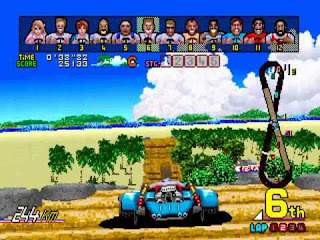Now considering this seemed to be the only English literary skills these Japanese had acquired (not including the obligatory "made in Japan"situated round back), I thought I knew enough to operate this Eastern wonder.
The game I had received with this small yet powerful console was Power Drift. This was originally an arcade game by Sega, and in the previous months I had sunk my entire years saving into its coin munching slot. So it was with ecstatic excitement and the highest of expectations that I inserted the game cartridge into the slot. Power Drift was now mine to own forever!
Immediately on sliding the "on" button some unintelligible Japanese jargon appeared on the screen. Being not very fluent in Japanese I followed the only due course of action available, and pressed the little red button on the controller which was made conspicuous by its prominent position. And again the miniaturized technical wunderkind responded with a perfect reproduction of the theme tune that had become so imprinted on the inner walls of my brain when at the arcade playing Power Drifts big coin op brother.
Suddenly, getting over my awe at the unlimited potential of this wondrous invention, I was acutely aware that the limitations were eternity. In front of me the screen ominously seemed to have vanished, and I had somehow entered a world where Japanese scientists could create a new reality at the touch of a button.
The start line was now in view, my engine was growling so ferociously it would make a jumbo jet run for cover. I was lined up with hoodlums in their own screaming pocket rockets to the left and right of me, in front and behind too. A quick glance around revealed a Californian type setting for this race, all perfectly simulated by the tiny computer box.
Too quickly, the red light, then the green light and we are off! The vehicle absolutely tore off the line like a tigers pounce. The ground seemed to provide no resistance as I gathered pace, while the crowds in-explicitly hostile chants were drowned out by the engine and my need to focus on the job at hand. All my attention now needed to be directed at battling the incredible G-Forces being exerted on what I felt was a jelly like body.
And now there was more important... A corner to be... A bridge coming... A long straight flashes by... Going up... Going down... Pass a car... All happening so fast...
Wow. Lap 1 negotiated, phew. My instincts and skills garnered from all those hours playing the arcade game have enabled me to immediately perform all these audacious maneuvers which are simply not possible for a normal, mortal, destructible human being. Yes, that was it, I felt indestructible.
Lap 2. Feels like a flash of unadulterated brutal murder to my person. Hair flying, adrenaline pumping, power surging action pouring out from deep inside me, exceeding my human limitations.
Lap 3, my body is now aching, going beyond all of its structural boundaries. My muscles feel as if they are tearing away from my bones in every sweeping corner. I hold on.
Out of the corner of my eye, a leader board appears and I realize that I am in fourth position with two cars directly ahead of me. We are approaching a part of the track which narrows and goes onto a bridge. They are just as exhausted as me, maybe more so. As we go over the bridge one car misjudges the edge and loses control, his heavy car turns into something its not made for, while I don't make the same mistake as I don't have a pilots licence.
As we enter Lap 4 I am in third position. Now both cars ahead are in sight. My car surges forward, never failing and I push it harder and harder. I need the glory that comes with a win, even though I knew the other drivers wanted it just as much.
I made my way slowly up to the car in second, and dove through at the next corner, he reacted too late to close the door and I was past. I could hear his exhausted body and car join as one and cry out in exasperation as I disappeared off into the distance
Only one more car to pass.
I pressed on and pushed myself to the limit, then over the limit. And in a flash I was past her too, into the lead! I just had the last bridge left to negotiate, I was already starting to celebrate.
Wait...
As I navigate this last obstacle I begin to feel a strange sensation. Is the car overheating? No! Is the feeling of immanent victory playing on my nerves? NO! What was it?
Oh no! The fated, the hated uncontrollable Power Drift had struck. Confusion and Pandemonium. The car slid here, or was it there. Up and down, round and round.
Metal crunched into turf and the whole thing exploded with a brutal fury. There would be no beautiful glory, not on this day.
"Game Over, Game Over" shouted the universe in a tiny white box. Exhausted, I struggled to sit upright. I was back in the real world, sitting in front of my TV, controller in hand.
The Japanese geniuses had invented a machine that had you addicted enough to ensure you return again and again every time you die. They could reincarnate you at the touch of a button, the little red button so conspicuous on the front of my controller.
I press it again...




